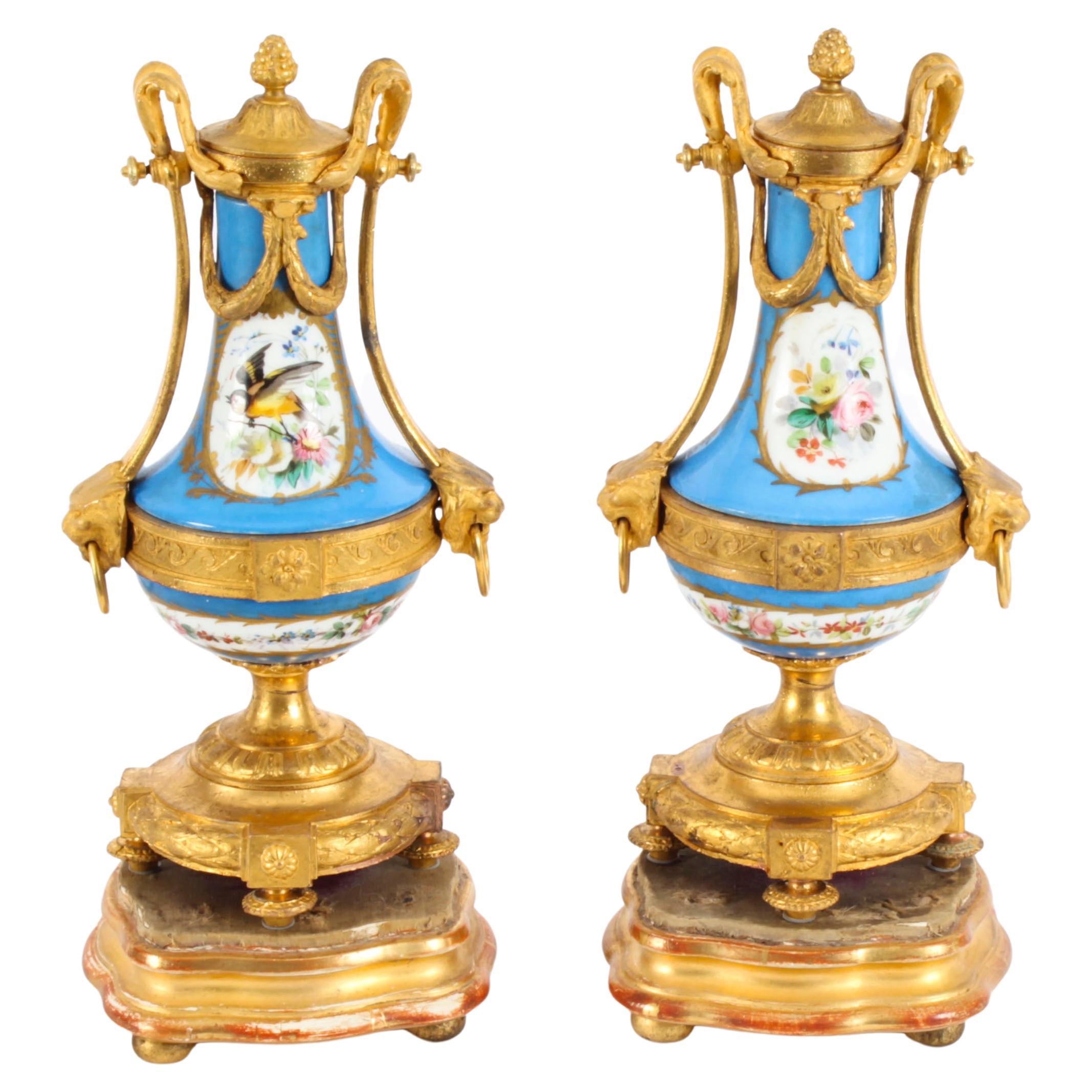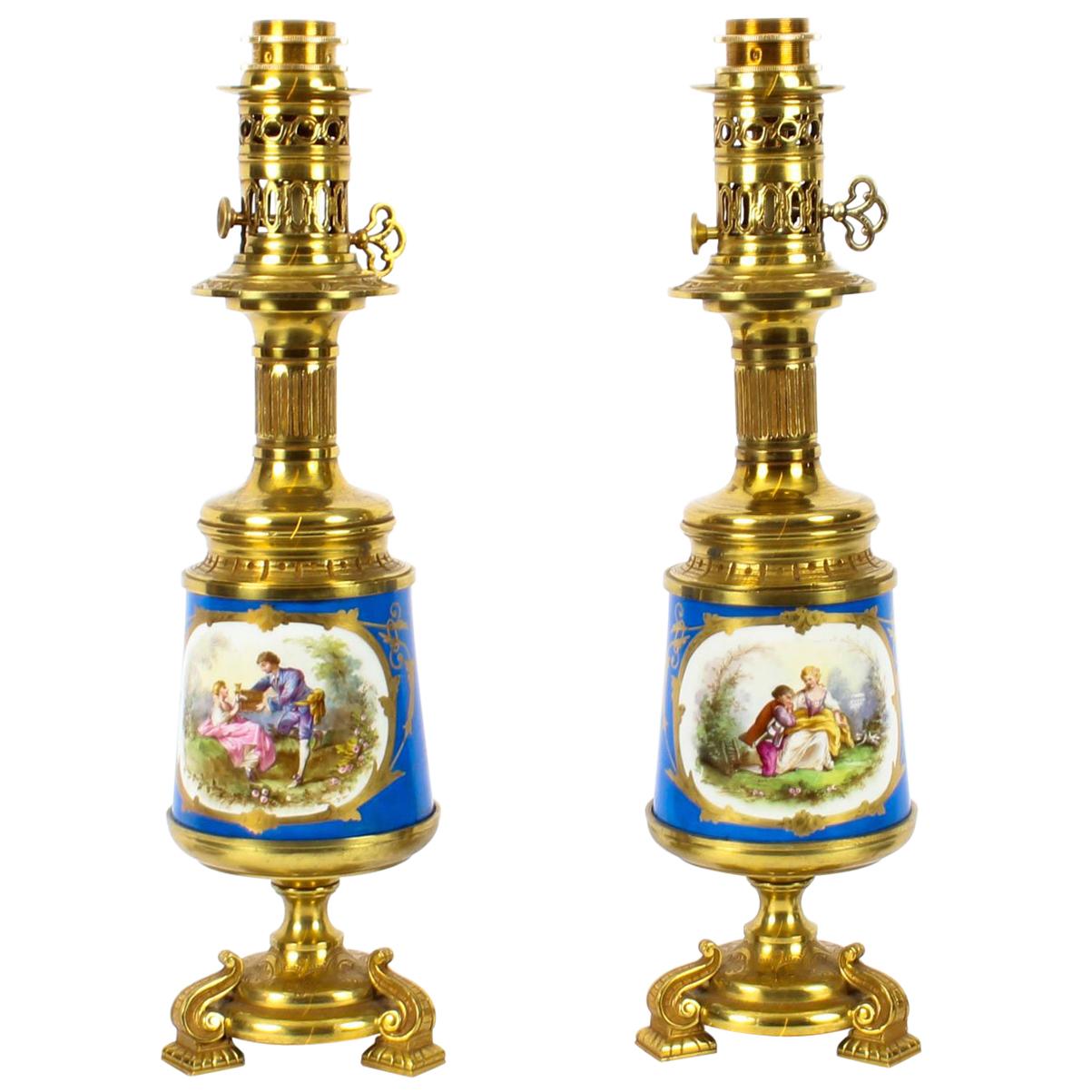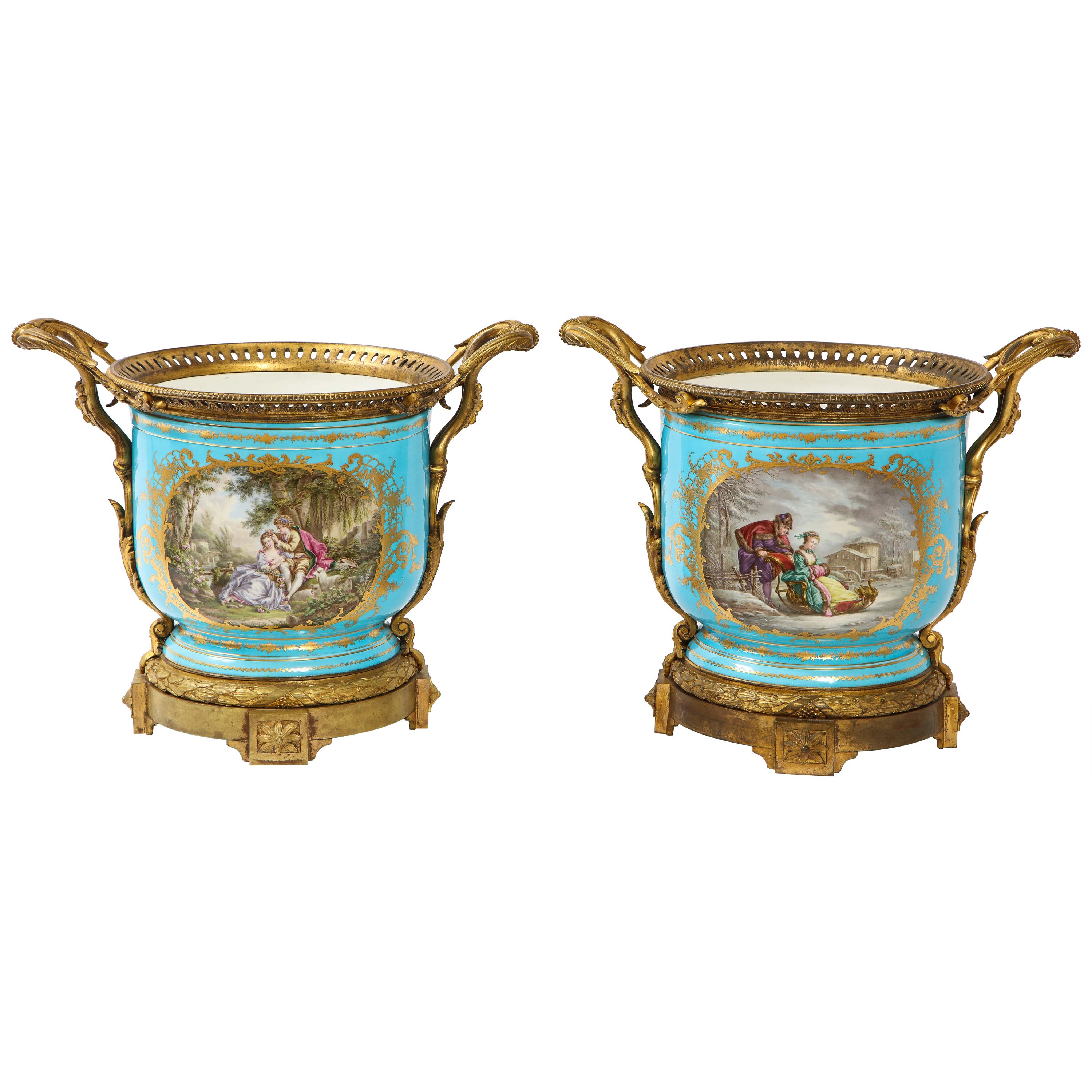Items Similar to Antique Pair of French Bleu Celeste Porcelain Urns 19th Century
Video Loading
Want more images or videos?
Request additional images or videos from the seller
1 of 22
Antique Pair of French Bleu Celeste Porcelain Urns 19th Century
About the Item
This is a fine and rare antique pair of French porcelain ormolu mounted twin handled urns in the Sevres manner, dating from Circa 1860.
The decorative twin handle vases are superbly decorated with high-quality hand painted panels of romantic domestic scenes on one side and landscapes on the verso, on a bleu celeste and richly gilded ground with red jewelled borders , the handles formed as serpents.
There is no mistaking the quality and unique design of this pair of urns which is sure to be a treasured addition to your home.
Condition:
In excellent condition with no chips, cracks or signs of repair, and only minor signs of wear comensurate with age and use, please see photos for confirmation of condition.
Dimensions in cm:
Height 22 x Width 13 x Depth 9
Dimensions in inches:
Height 9 inches x Width 5 inches x Depth 3 inches
Sevres Porcelain traces its roots in France to early craftsmen who had small manufacturing operations in such places as Lille, Rouen. St. Cloud, and most notably Chantilly. It is from Chantilly that a cadre of workers migrated to the Chateau de Vincennes near Paris to form a larger porcelain manufactory in 1738.
French King Louis XV, perhaps inspired by his rumoured relationship with mistress Madame de Pompadour, took an intense interest in porcelain and moved the operation in 1756 to even larger quarters in the Paris suburb of Sevres. Sevres was also conveniently near the home of Madame de Pompadour and the King's own Palace at Versailles.
From the outset the king's clear aim was to produce Sevres Porcelain that surpassed the established Saxony works of Meissen and Dresden. Though the French lacked an ample supply of kaolin, a required ingredient for hard-paste porcelain (pate dure), their soft-paste porcelain (pate tendre) was fired at a lower temperature and was thus compatible with a wider variety of colours and glazes that in many cases were also richer and more vivid. Unglazed white Sevres Porcelain "biscuit" figurines were also a great success. However, soft-paste Sevres Porcelain was more easily broken. Therefore, early pieces of Sevres Porcelain that remain intact have become rare indeed.
The Sevres Porcelain manufactory always seemed to be in dire financial straits despite the incredibly fine works it produced. In fact, the king's insistence that only the finest items be created may have contributed to the difficulties. Only a limited number of European nobility could afford the extravagant prices demanded for such works. King Louis XV and eventually his heir, the ill-fated Louis XVI, were obliged to invest heavily in the enterprise. Ultimately, the Sevres Porcelain Factory produced items under the name of "Royal" and thus the well-known Sevres mark was born. King Louis XV even mandated laws that severely restricted other porcelain production in France so as to retain a near monopoly for his Sevres Porcelain. The king even willingly became chief salesman for the finest of his products, hosting an annual New Year's Day showing for French nobility in his private quarters at Versailles. He eagerly circulated among potential buyers, pitching the merits of ownership and policing the occasional light-fingered guest.
Sevres Porcelain may have indeed given the makers of Meissen and Dresden a run for their money by the end of the 18th Century but for the French Revolution. By 1800, the Sevres Porcelain Works were practically out of business due to the economic devastation of the new French Republic.
About the time when Napoleon Bonaparte named himself Emperor of France (1804), a new director was named for the Sevres Porcelain Manufactory. Alexandre Brongniart, highly educated in many fields, resurrected Sevres Porcelain. Soft-paste porcelain was eliminated altogether thanks to the earlier discovery of kaolin near Limoges. For four decades until his death, Brongniart presided over monumental progress for Sevres Porcelain, catering not only to Napoleon himself, but at last to include the more financially profitable mid-priced market in the emerging middle class.
Ormolu (from French 'or moulu', signifying ground or pounded gold) is an 18th-century English term for applying finely ground, high-carat gold in a mercury amalgam to an object of bronze.The mercury is driven off in a kiln leaving behind a gold-coloured veneer known as 'gilt bronze'.
The manufacture of true ormolu employs a process known as mercury-gilding or fire-gilding, in which a solution of nitrate of mercury is applied to a piece of copper, brass, or bronze, followed by the application of an amalgam of gold and mercury. The item was then exposed to extreme heat until the mercury burned off and the gold remained, adhered to the metal object.
No true ormolu was produced in France after around 1830 because legislation had outlawed the use of mercury. Therefore, other techniques were used instead but nothing surpasses the original mercury-firing ormolu method for sheer beauty and richness of colour. Electroplating is the most common modern technique. Ormolu techniques are essentially the same as those used on silver, to produce silver-gilt (also known as vermeil).
Our reference: A2804.
- Dimensions:Height: 8.67 in (22 cm)Width: 5.12 in (13 cm)Depth: 3.55 in (9 cm)
- Sold As:Set of 2
- Materials and Techniques:
- Place of Origin:
- Period:
- Date of Manufacture:circa 1860
- Condition:
- Seller Location:London, GB
- Reference Number:
About the Seller
5.0
Platinum Seller
These expertly vetted sellers are 1stDibs' most experienced sellers and are rated highest by our customers.
Established in 1983
1stDibs seller since 2012
1,196 sales on 1stDibs
Typical response time: 1 hour
Associations
LAPADA - The Association of Arts & Antiques Dealers
- ShippingRetrieving quote...Ships From: London, United Kingdom
- Return PolicyA return for this item may be initiated within 14 days of delivery.
More From This SellerView All
- Antique Pair French Bleu Celeste Sevres Urns 19th CLocated in London, GBThis is a beautiful antique pair of French Sevres style porcelain and ormolu mounted twin handled urns, in the Louis XV manner, Circa 1870 in date. The bleu celeste...Category
Antique 1870s French Urns
MaterialsOrmolu
- Antique Pair of French Bleu Celeste Sèvres Vases Lamps, 19th CenturyLocated in London, GBThis is an exquisite large pair of French Sèvres Porcelain and ormolu mounted oil burning table lamps that have been skillfully converted to electricity ...Category
Antique 1870s French Porcelain
MaterialsOrmolu
- Antique Bleu Royale Sèvres Porcelain Ormolu Table Lamp, 19th CenturyLocated in London, GBThis is a stunning large antique French Sèvres "Bleu Royale" hand painted porcelain and ormolu-mounted vase circa 1870 in date, later converted into a lamp. The ovoid porcelain bo...Category
Antique 1870s French Porcelain
MaterialsOrmolu
- Antique Large French Sevres Porcelain Casket 19th CenturyLocated in London, GBThis is a fabulous, larger than usual, antique French Sevres porcelain ormolu mounted casket, Circa 1860 in date. The shaped hinged cover decorated with a hand painted courting cou...Category
Antique 1860s French Porcelain
MaterialsPorcelain
- Antique French Pink Porcelain Cabinet Plate, 19th CenturyLocated in London, GBThis is an absolutely fabulous antique hand painted French porcelain pink ground cabinet plate, circa 1880 in date. It is fine...Category
Antique 1880s French Porcelain
MaterialsPorcelain
- Antique Pair Sevres Bleu Celeste Porcelain & Ormolu Candelabra 19th CLocated in London, GBA pair of late 19th century French porcelain and ormolu mounted three light candelabra, each with floral and leaf branches above cherubic central column, to floral painted porcelain ...Category
Antique 1860s French Candelabras
MaterialsOrmolu
You May Also Like
- Monumental Pair of 19th Century French Sèvres Celeste Blue Porcelain CachepotsBy Manufacture Nationale de SèvresLocated in New York, NYA monumental and rare pair of 19th century French dore bronze mounted Sèvres Celeste blue porcelain cachepots. These cache pots are extremely rare to fi...Category
Antique 1860s French Louis XVI Planters, Cachepots and Jardinières
MaterialsBronze
- Pair Old Paris 'Vieux Paris' Porcelain Urns, France, 19th CenturyBy Old ParisLocated in Chappaqua, NYPair Old Paris porcelain urns, France, 19th Century. Hand-painted classical form urns. A different landscape scene on each urn. Lovely co...Category
Antique 1830s French Empire Porcelain
MaterialsPorcelain
- Pair of 19th Century French Paris Porcelain Urns with Painted Scenes & HandlesLocated in Atlanta, GAPair of 19th century French Paris porcelain urns with painted scenes and handles.Category
Antique 19th Century French Urns
MaterialsPorcelain
- Pair of 19th Century French Porcelain FiguresLocated in Los Angeles, CAPair of very fine 19th century hand-painted porcelain figures.Category
Antique 19th Century French Porcelain
MaterialsPorcelain
- Sevres France Porcelain Large Decorative Urn, Late 19th CenturyLocated in Gardena, CASevres France porcelain large decorative urn, Late 19th Century. The central band depicting various period era court scenes. Artist signed "C.Velly" to the center edge. A cobalt blue...Category
Antique 19th Century Porcelain
MaterialsPorcelain
- Pair of Porcelain Vases, France, Late 19th CenturyLocated in Buenos Aires, Buenos AiresPair of porcelain vases, France, late 19th century.Category
Antique Late 19th Century French Neoclassical Vases
MaterialsPorcelain
Recently Viewed
View AllMore Ways To Browse
French Vermeil
French Silver Vermeil
Antique Market Paris France
Antique French Ormolu Piece
French Panel Antique Pair
Antique Glass Urns
French With Porcelain Panels
Small French Antique Vases
French Sevres Fine Porcelain
White Porcelain Sevres
Brass And Gold Gilt 18th Century
Antique Brass And Copper Items
Antique Urn Silver
Ormolu Mercury Gold
Pair Of Emperor
Antique English Urns
Louis Xvi Sevres Porcelain
French Antique Glass Ormolu





